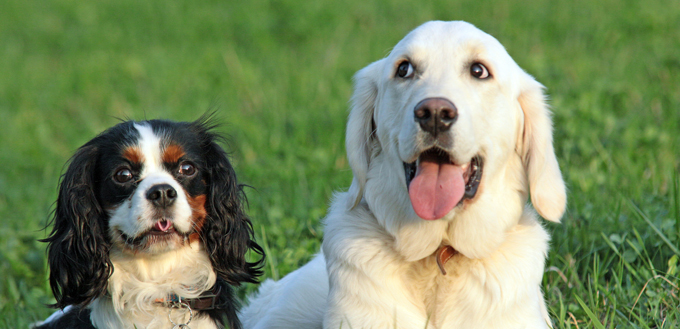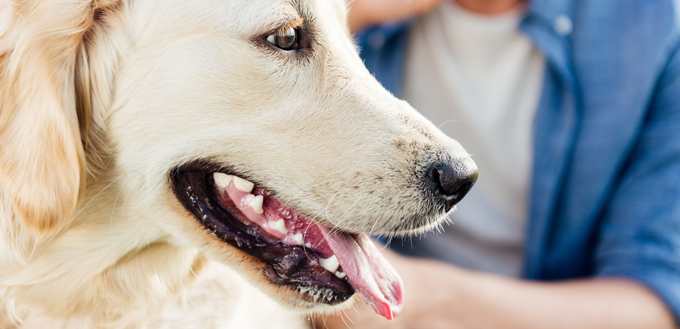They eat with it, drink with it, and lick your face with it. But that isn’t everything you might want to know about your dog’s tongue. There are all sorts of odd, interesting and useful facts that you can learn. As Dr. Alexander Reiter of the University of Pennsylvania in Philadelphia says, ‘The tongue is an essential part of the mouth in a dog’, so learning more might just help you to care for your best friend, or at least could be a fun little fact to share with your fellow dog lovers.
Related Post: Gifts for Dog Lovers

The Tongue: What is it?
First, let’s quickly go over what the tongue actually is. Everyone knows it helps us talk and lets us taste. But, medically, what is it? Dr. Ann Hohenhaus from New York’s Animal Medical Center explains, ‘The tongue is a muscle. Like all muscles, it’s controlled by nerves. And in the case of the tongue, the nerves come straight off the brain to control the tongue.’
Taste buds are cells that are very similar to nerves and they also connect to the brain to tell you if what you are tasting is sour, sweet, bitter and salty. Many people believe that you can ‘map’ these taste buds because different parts of the tongue are responsible for the different tastes. This is just a myth as taste buds are spread evenly all over the tongue.
Dogs’ Tongues Are Just as Dirty as Human Tongues
Another myth about tongues is that dogs have cleaner tongues than humans. This belief comes from the idea that dogs lick their wounds because it helps the wound to heal. Some people believe that dog saliva heals wounds, but this isn’t true. If licking helps wounds, it is only because the physical movement of the tongue could dislodge dirt.
The truth is that dogs and humans both have over 600 different forms of bacteria, and that huge number of bacteria is not going to be beneficial for any wound. I’ve even heard of people who try to encourage their dog to lick their human wounds because they believe it would help them to heal. This is not a good idea and you may even be risking infection.
Dogs’ Taste Buds
As mentioned earlier, taste buds are spread all over the tongue, not just in certain areas. Taste buds are another key difference between humans’ tongues and dogs’ tongues. Dogs have less taste buds than humans do by about a sixth. Scientists have estimated that dogs have on average 1,700 taste buds, while humans are estimated to have about 10,000.
Similarly, compared to a cat, dogs have more taste buds. These taste buds can taste bitter, salty, sweet and sour foods while cats can’t taste sweet foods, which must be boring for them! Recent research has even suggested that dogs have specifically specialised taste buds that can detect meat and water. Humans, on the other hand, often struggle to genuinely taste water as, generally, what you are tasting when you drink water is just the minerals, chemical and impurities.
Dogs are more dependent on their smell than both humans and cats and it has been suggested that they use their sense of smell to choose their food more than they use their sense of taste. Generally, their preference for smell and more limited taste buds make a dog’s sense of taste less sensitive than a human’s.
Dogs Also Like to Look Their Best
Everyone knows that cats use their tongues to keep themselves clean and tidy, and most dog owners know that dogs like to do this too. But did you know that dogs’ tongues are not as good at grooming as cats’ tongues? The infamously rough cat tongues have a purpose, and that is to catch as many knots and tangles as possible so that their coats are shiny and smooth. Dogs, on the other hand, have smooth tongues and this makes them less effective.
If you own a cat and a dog, it may be tempting to groom them the same amount, but this difference in tongues highlights that you may have to help your dog just a little more than you have to help your cat. Brush your best friend regularly to help keep them tangle free and looking sharp!
Related Post: Dog Shedding Brush

Keeping Cool on A Hot Day
As humans, when it is hot, we sweat. The sweat evaporates off our skin and this cools our skin and blood down, which helps us to manage our temperature. A strange fact about dogs is that they only have sweat glands on their paws and noses. This makes it much harder for them to cool down through sweating like we do.
Instead, dogs use their tongues to cool down on a hot day. You might think that dogs pant mostly when they exercise or exert themselves, but they also pant just to cool down. Panting makes air move quickly over the tongue and around the mouth and upper respiratory tract. This has the same effect of sweating as moisture can evaporate and lowers the temperature of their blood. It is estimated that a panting dog takes approximately 300 to 400 breaths per minutes instead of their usual 30 to 40.
The difficulty is that dogs don’t only pant when they are hot. Many dogs also pant when they are stressed, and you don’t want to miss it and neglect their feelings. If you are concerned that your dog might be panting because they are anxious ask yourself:
- What is the context? Are they in an enclosed space, or a loud or noisy situation?
- Is this different from their normal behavior? After all, you know your pet best.
- Do they have a strained facial expression, such as furrowed brows, large eyes or prominent veins or muscles?
If in doubt, you might want to take your dog into a new, calm situation and give them a bowl of water just to be safe.
Not All Dogs Have Pink Tongues
The oddest fact about dogs’ tongues is probably that there are two breeds whose tongues are blue! Chow Chows and Shar-Peis are Chinese breeds, and they are very closely genetically related, so it makes sense that they share this unusual trait. What is less clear is its origin. Based on the theory of evolution, it is likely that a decedent of these breeds mutated to exhibit this strange coloured tongue, but doctors have yet to understand what made this mutation spread to become so prevalent. How is having a blue tongue evolutionarily useful?
If you have a Chow Chow or a Shar-Pei, there are a few health issues you should be aware of. Mostly as a blue tongue can make diagnosis difficult for your veterinarian. Blue tongues are often a symptom of your dog’s body failing to oxygenate as they should be. This may mean that they may be suffering from lung or heat disease. If you have a different breed of dog and they have a blue tongue, you should take them to the vet. However, if you have a Chow Chow or a Shar-Pei, lung and heart disease can be more difficult to detect. Make sure you are aware of the other symptoms, such as shortness of breath.
Another breed that might not have entirely pink tongues is the Labrador. It is possible for some Labs to have a black spot on their tongue. Some think it happens when a Labrador is slightly cross-bred so has a distant relation to a Chow or a Shar-Pei. In reality, it is just a minor change in pigmentation that could even occur in a purebred and should be harmless. As long as it has been present since birth, or from a very young age, there is no cause for concern. But any unexpected change in colour or texture should be mentioned to your vet.
Dogs Can Have Tongues Too Big for Their Mouths
Macroglossia is an extremely rare condition. Dr. Reiter, for example, reports that he has only seen two examples across his entire 20 year career. Macroglossia essentially means that dogs tongues are larger than normal and, crucially, too large for many normal functions. A puppy with macroglossia, for example, might be struggling to suckle at their mother’s teat.
As it is incredibly rare, it is unlikely that you need to pay special attention to the size of your dogs tongue. However, like many conditions, some breeds are more likely to suffer from large tongues than others. Boxers in particular are known for their large tongues which hang out of their mouths. They don’t necessarily experience problems as a result of these large tongues, but if you have concerns then there are treatments and even surgical options.
Using Their Tongues to Quench Their Thirst
Another fact that many people are aware of is that dogs use their tongues in order to drink water. You’ve probably seen your puppy drink from his bowl and seen him lap up the water with his tongue. But, did you know that he is drinking water very differently from how cats lap up water?
Cats also drink water using their tongues. They dip their tongue into the water and then flick the water up so that they can catch it in their mouths. Dogs, on the other hand, curl their tongue into a small dog bowl or ladle which pulls the water into their mouths. Both happen so fast that it is difficult to see the difference, but now that you know you might just notice when they are next taking a drink.
Related Post: Dog Bowls
Tongues Might Affect Barking
Our tongues affect our speech. Try saying an ‘L’ without using your tongue – it’s impossible, right? The same is true for dogs. Dogs’ tongues are long and narrow when compared to humans’ tongues, and they also move in a different way as they aren’t need for pronunciation. But, that doesn’t mean that their tongues have no effect on their sound.
While dogs don’t have a whole alphabet to work with, the size of their tongues does impact the sound of their bark. Barks aren’t made by the tongue, but the tongue will impact the amount of free space in the mouth, which impacts the echo effect and tone of the bark. A good analogy to understand this is the change of pitch that occurs in glasses when you fill them with different volumes of water and tap them.

Using Their Tongues to Express Themselves
If you own a dog, you know they often use licking to show how they are feeling. They might offer you ‘kisses’ when they are happy to see you, or they might lick themselves when they are feeling anxious. There are all sorts of behaviors that dog exhibit, but this doesn’t make it easy to understand what they are trying to say.
Most doctors agree that, similar to babies, dogs use their tongues and mouths to explore their world. For example, they learn what is food and what might make them ill through licking and testing various objects out. You might have noticed that many harmful things in nature are often inherently bitter. This might also be why you need to trick your dog into taking bitter medicine by hiding it in something yummy like a hotdog.
Related Post: Best Dog Pill Shooter
It is worth noting, however, that while it might be nice to feel your dog’s love, there can be some dangers associated with allowing them to lick your face. Very few diseases can cross between species, but research has begun to show that certain bacteria causing periodontal disease can cross between humans and dogs. So be careful – it may be worthwhile training your dog out of that particular behaviour.
Sources:
- Teresa K. Traverse, 9 Facts About Your Dog’s Tongue, PetMD
- Difficulty Breathing – Symptoms of Pets with Heart Disease, Tufts






